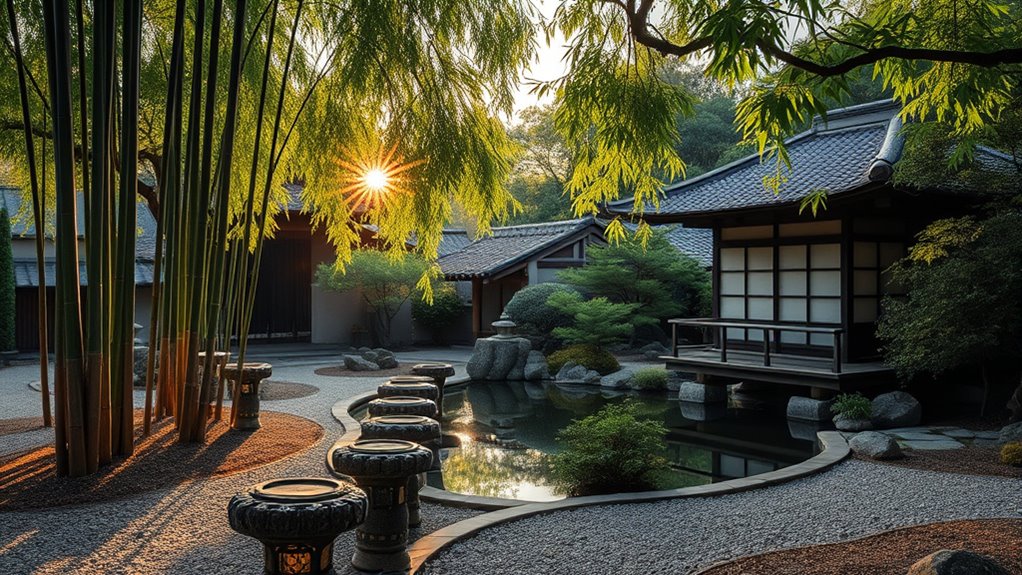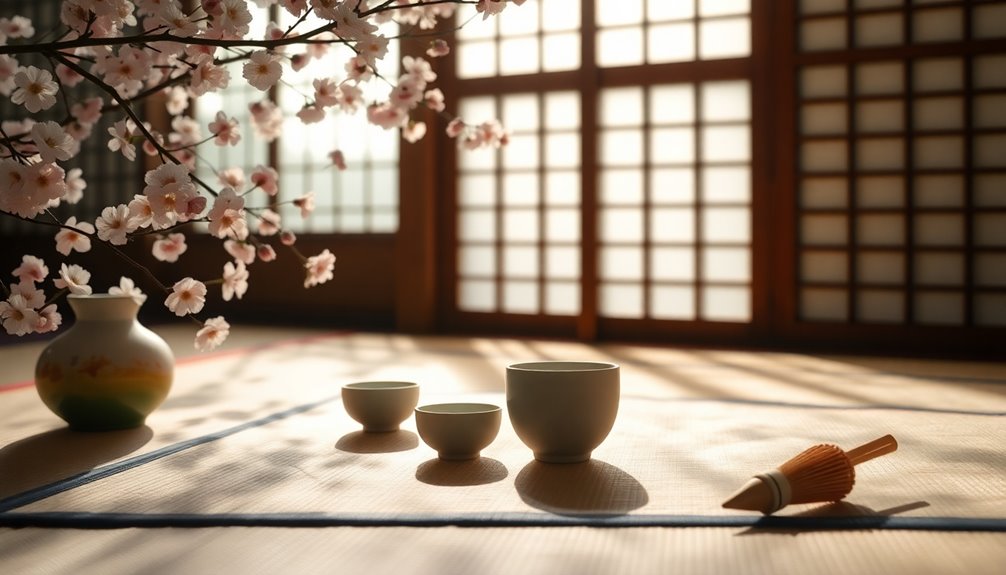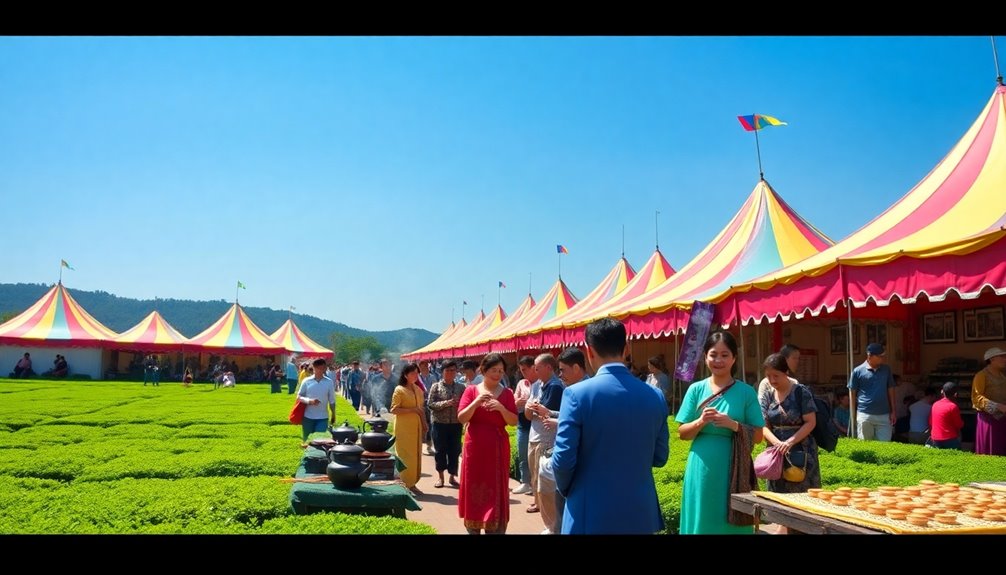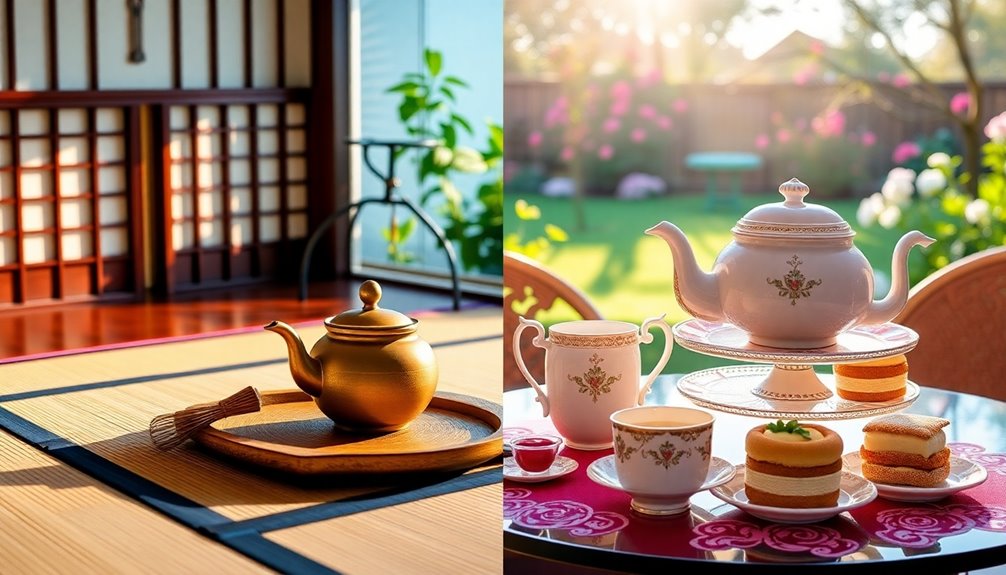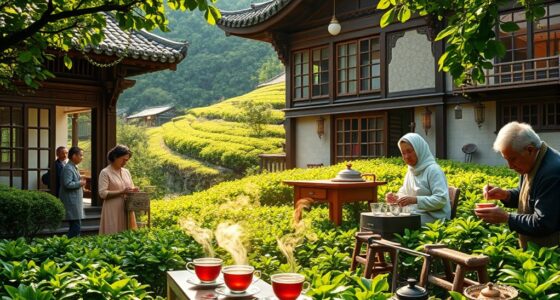Ancient Japanese tea gardens reflect centuries-old cultural values, emphasizing harmony with nature, simplicity, and mindfulness. You’ll notice natural materials like gravel, moss, and stones carefully placed to symbolize mountains, islands, and animals, guiding your movement and focus. They serve as serene spaces for the tea ceremony, embodying principles like wabi-sabi and mono no aware, highlighting imperfection and life’s transience. If you explore further, you’ll uncover the deep symbolism woven into these tranquil landscapes.
Key Takeaways
- They embody principles of wabi-sabi, highlighting beauty in imperfection and transience.
- Rocks and stones symbolize mountains, islands, or animals, guiding movement and focus.
- Water features represent purity and tranquility, enhancing the garden’s spiritual atmosphere.
- Asymmetrical, naturalistic layouts evoke organic beauty and mindfulness in design.
- Garden elements reflect cultural values of humility, harmony, and connection with nature.
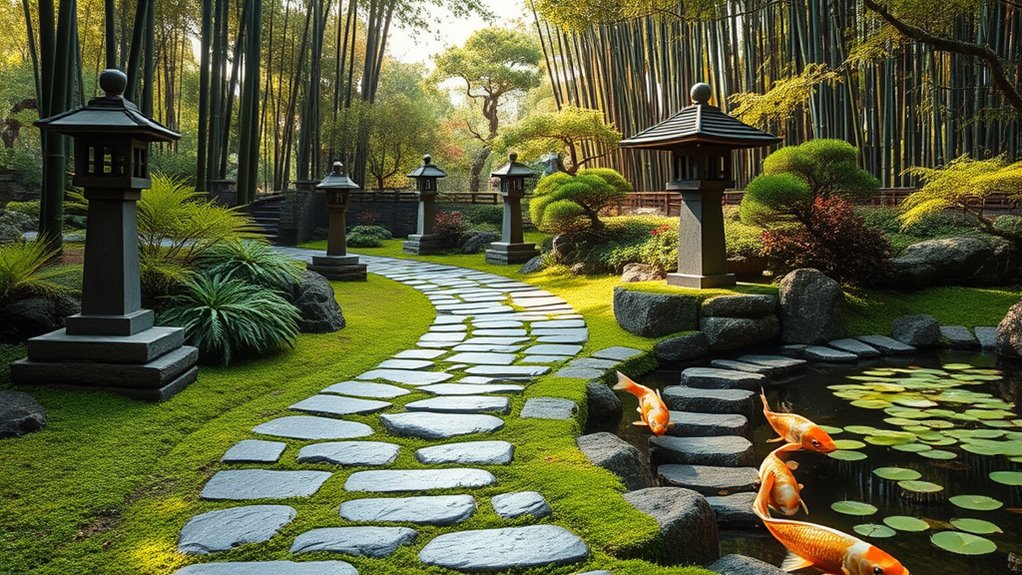
Have you ever wondered how ancient Japanese tea gardens reflect centuries of cultural tradition and aesthetic principles? These gardens aren’t just pretty landscapes; they’re carefully crafted spaces that embody Japan’s deep respect for nature, harmony, and spiritual practice. At the heart of many of these gardens is the tea ceremony, a ritual that emphasizes simplicity, mindfulness, and connection. The garden design surrounding a tea house is integral to this experience, guiding you through a deliberate journey that enhances the ceremony’s meaning. Every element, from winding paths to carefully placed stones, serves to create a tranquil environment where you can appreciate the beauty of the moment.
In traditional Japanese garden design, every feature is intentional, symbolizing broader philosophical ideas. For example, the use of natural materials like gravel, moss, and wood reflects a reverence for nature’s impermanence and beauty. The placement of rocks and stepping stones isn’t random; they’re arranged to evoke natural landscapes and to symbolize mountains, islands, or animals, fostering a sense of harmony with the environment. These elements also serve practical purposes, guiding your movement and focus, helping you shift from the outside world into a meditative state. As you move along the garden’s pathways, you’re subtly encouraged to slow down, breathe, and become present.
The tea garden design often incorporates a “stroll garden” layout, inviting you to walk a specific route that reveals new vistas and details at each turn. This intentional pacing aligns with the principles of the tea ceremony, which values mindfulness and simplicity. The garden’s layout often includes a small pond or water feature, representing purity and tranquility, and a tea house that’s intentionally modest, reflecting humility and understated elegance. The garden’s asymmetry and naturalistic style break away from rigid symmetry, emphasizing organic beauty and spontaneity, which are core to Japanese aesthetic ideals. Furthermore, these gardens often incorporate symbolic elements that deepen their cultural significance.
Ultimately, these gardens serve as living symbols of philosophical principles like wabi-sabi—beauty in imperfection—and mono no aware, an awareness of transience. You’re encouraged to observe and appreciate each detail, recognizing that the garden’s design mirrors the transient nature of life. When you participate in a tea ceremony within such a garden, you’re immersed in a space that’s rich with symbolism—each stone, plant, and structure working together to evoke serenity, humility, and a deep connection to nature. It’s this thoughtful garden design that elevates a simple gathering into a profound cultural experience, rooted in centuries of tradition.
Frequently Asked Questions
What Are the Origins of Japanese Tea Garden Design?
You might wonder where Japanese tea garden design originated. It stems from Zen philosophy, emphasizing simplicity and harmony with nature. These gardens focus on creating a peaceful, aesthetic space that encourages meditation and reflection. The principles of garden aesthetics guide their layout, using natural elements like rocks, water, and plants to symbolize broader spiritual ideas. This thoughtful design aims to foster tranquility and mindfulness, deeply rooted in Japanese cultural and spiritual traditions.
How Do Tea Gardens Influence Japanese Cultural Identity?
You see that tea garden symbolism plays a essential role in shaping Japanese cultural identity. By visiting these gardens, you experience a deep connection to traditions and values, fostering cultural preservation. The careful design reflects harmony, respect, and mindfulness, which are core to Japan’s heritage. Engaging with tea gardens helps you appreciate and uphold these cultural elements, ensuring their significance continues to thrive in modern society.
Are There Specific Rituals Associated With Visiting Tea Gardens?
When you visit a tea garden, you’re invited to participate in a serene ritual. The tea ceremony unfolds with precise steps, emphasizing mindfulness and respect. You follow garden etiquette, bowing gently and handling utensils with care. This ritual creates a tranquil connection between you and the surroundings, transforming a simple visit into a meaningful experience rooted in tradition and harmony. It’s more than just tea; it’s a cultural journey.
What Types of Plants Are Traditionally Used in Tea Gardens?
You’ll find that traditional tea gardens feature plants like the tea plant, which symbolizes serenity and renewal. Botanical arrangements often include moss, bamboo, and flowering trees, creating a harmonious atmosphere. These plants aren’t just for aesthetics; they embody tea plant symbolism, representing purity and tranquility. When you walk through, notice how each plant contributes to the garden’s calming ambiance, enhancing your tea experience through thoughtful botanical arrangements.
How Have Modern Influences Changed Traditional Japanese Tea Gardens?
Modern influences have transformed traditional Japanese tea gardens by incorporating contemporary landscaping techniques and adapting to urban development. You’ll notice a blending of natural elements with minimalist designs, making gardens more accessible in city environments. Urban development often introduces new materials and structures, which can alter traditional layouts. Despite these changes, many still aim to preserve the garden’s tranquil essence, balancing modern aesthetics with cultural heritage.
Conclusion
As you leave the ancient Japanese tea gardens, remember that each stone and plant symbolizes harmony and serenity. These gardens aren’t just beautiful spaces but mirrors of your inner peace, guiding you to reflect and find balance. Just as each element is carefully placed to evoke calm, your journey through these gardens reminds you that tranquility is always within reach. Embrace their symbolism, and let it inspire harmony in your own life’s garden.

